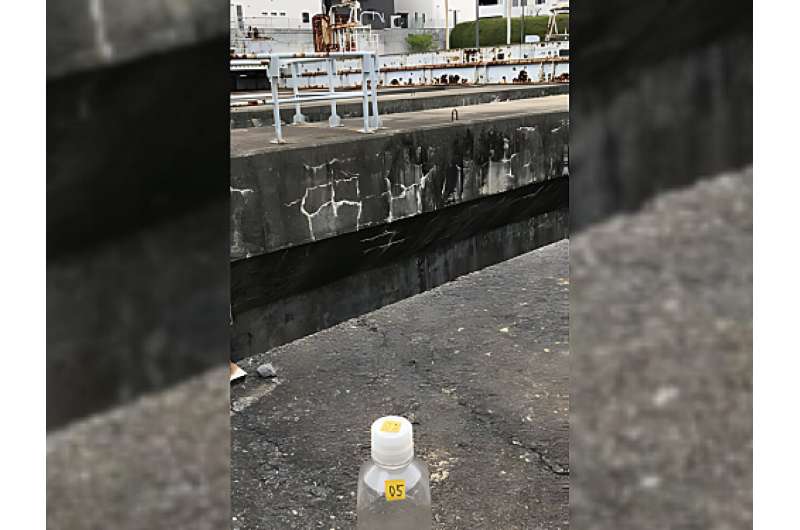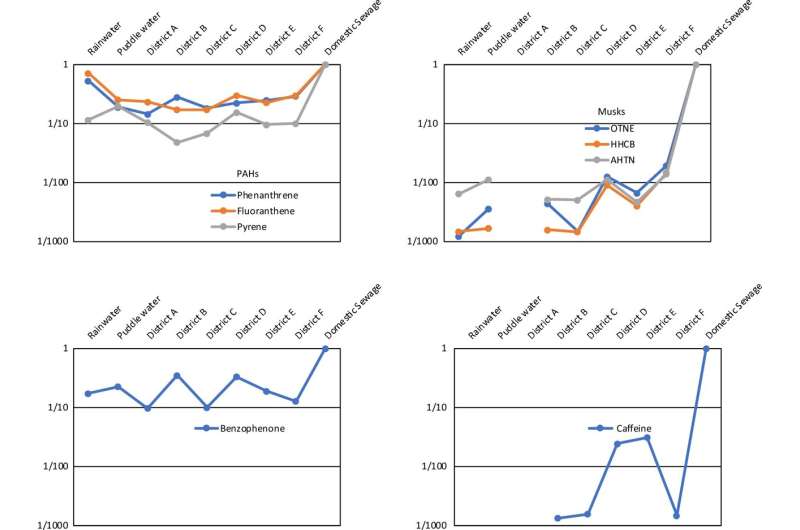This article has been reviewed according to Science X's editorial process and policies. Editors have highlighted the following attributes while ensuring the content's credibility:
fact-checked
trusted source
proofread
Caffeine may be a useful marker of wastewater leaks in storm drain systems

In developed countries such as Japan, wastewater systems designed to keep harmful pollutants out of storm drainage are aging and deteriorating, sending contaminants into local bodies of water. Finding the source of a leak in wastewater systems that are often buried far underground can be challenging. The conventional method can miss leaks, and it cannot detect leaks found downstream.
Researchers have proposed using the levels of caffeine, a common household pollutant that isn't otherwise found in the environment, to find likely sources of leaks in wastewater systems. The findings were shared in a paper published in Environmental Chemistry Letters on 5 April 2024.
"For a long time, wastewater and storm runoff were combined to form sewer systems. The problem of combined sewer overflows during rainstorms has been long-standing, so the system was changed to separate the sewer from the storm drain around 50 years ago.
"However, even in the case of newer, separate sewer systems, the possibility of sewage leakage due to aging pipelines is becoming a concern because the oldest ones have been in the ground for five decades," said Noriatsu Ozaki, an associate professor at Hiroshima University's Graduate School of Advanced Science and Engineering in Higashihiroshima, Japan.
From June 2022 to May 2023, researchers collected water from storm drains during dry periods from six urban drainage areas once or twice a month. At each collection point, they collected samples five to 11 times.

They also collected rainwater, puddle water, and domestic sewage samples. They tested multiple common household chemicals, including fragrance compounds frequently found in soaps, detergents, and cosmetics including OTNE, HHCB, AHTN, DPMI, and musk ketone; caffeine; and benzophenone, a common sunscreen ingredient.
"These compounds are consistently detected in domestic wastewater in Japan," said Ozaki. "In addition, three polycyclic aromatic hydrocarbons (PAHs), which are commonly used as indicators of air and urban surface pollution, were also measured."
To get a baseline reference, researchers measured how frequently these chemicals are found in rainwater and puddle water. PAHs were detected 80% of the time, most of the fragrances were found 60% to 82% of the time, and benzophenone was found 100% of the time in rainwater and 90% of the time in puddle water. Caffeine and the fragrance compounds DPMI and musk ketone, however, were much lower. They were detected less than half the time in rainwater and puddle water.
PAHs and benzophenones were so abundant in rainwater and puddle water that it is difficult to distinguish the source of elevated levels of these chemical compounds in the storm drains to identify leaks. The level of contamination between the rainwater, the domestic sewage, and the storm drains in the districts measured was only different by one order of magnitude. For the three fragrances, there was a more significant difference, with two or more orders of magnitude between the tested storm drains and the domestic sewage.
However, the level of contamination of caffeine was distinctly different for rainwater and puddle water, storm drainages, and domestic sewage. There is little to no recirculation of caffeine into the drainage system via rainfall and the source of any caffeine in runoff could be attributed to domestic sewage. Caffeine is also the most stable in the water phase among the tested chemicals and it could be, in theory, easy to use as a tracer for future research.
Looking ahead, researchers want to understand more about the pollution caused by these leaks. "We want to clarify the extent of the possible pollution of the receiving public water bodies, such as rivers, lakes, or coastal areas, by the leaks," said Ozaki. "And finally, we want to develop the diagnostic technology to indicate the leakage at the site using the trace organic chemicals as an indicator."
More information: Noriatsu Ozaki et al, High caffeine levels in old sewer system waters reveal domestic wastewater leakage, Environmental Chemistry Letters (2024). DOI: 10.1007/s10311-024-01733-3
Provided by Hiroshima University




















